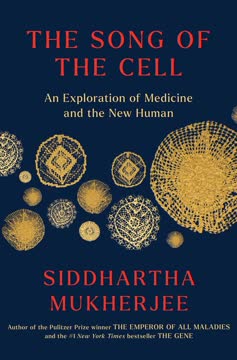Key Takeaways
1. Life Transcends Mechanical Metaphors
There never has been a machine made by humankind that works as cells do.
Beyond the Machine. The long-standing analogy of living systems as machines, while historically useful, ultimately falls short. Cells operate with a logic fundamentally different from any engineered system we've created. This perspective shifts the focus from viewing organisms as collections of parts with fixed functions to understanding them as dynamic, self-organizing entities.
Molecular-Scale Differences. The molecular world operates under different physical conditions than our macroscopic world. Concepts like viscosity, friction, and adhesion behave differently at the molecular scale, rendering machine metaphors inadequate. This necessitates a new way of thinking about biological processes, one that acknowledges the unique properties of the molecular realm.
Embracing Complexity. The failure of the machine analogy invites us to explore the true nature of life, moving beyond simplistic comparisons to technology. This involves recognizing the limitations of current metaphors and developing new frameworks that capture the emergent, versatile, adaptive, and robust qualities of living systems.
2. Genes Serve, Not Dictate
They are servants, not masters.
Genes as Resources. The traditional view of genes as blueprints or instruction manuals is inaccurate. Genes are better understood as resources that cells utilize within a complex, self-organizing system. This perspective shifts the emphasis from genetic determinism to a more nuanced understanding of how genes interact with other cellular components and environmental factors.
Beyond Genetic Control. While genes play a crucial role in heredity and evolution, they do not possess any real agency or decision-making capacity. They are acted upon by cellular processes and environmental cues, highlighting the importance of factors beyond the genome in shaping life. This challenges the notion of genes as selfish and authoritarian dictators.
Trust in Processes. Genes rely on processes beyond their direct control to enable organisms to grow, thrive, and evolve. This "trust" in self-organization is a recurring theme in biology, particularly in complex systems like multicellularity and cognition. It underscores the importance of emergent properties and decentralized control in living organisms.
3. DNA: A Resource, Not a Blueprint
The aim of this book is to show why these metaphors are inadequate, why they need replacing, and why we will not understand how life works until we do.
Beyond the Blueprint. The metaphor of DNA as a blueprint or instruction manual is misleading because it implies a pre-determined plan for the organism. In reality, DNA provides a set of resources that cells use to construct themselves in response to environmental cues and internal processes. This challenges the notion of genetic determinism and highlights the importance of context in shaping life.
Dynamic Information. DNA is not a static repository of information but a dynamic molecule that interacts with other cellular components. The way DNA is packaged, transcribed, and translated is influenced by a variety of factors, including epigenetic modifications and RNA regulation. This dynamic interplay challenges the linear view of information flow from DNA to proteins.
Evolving Understanding. The discovery of DNA's structure launched the genetic age, but it also created a set of misleading metaphors that have persisted for decades. Replacing these metaphors with a more nuanced understanding of DNA as a resource is essential for advancing our knowledge of how life works.
4. RNA: The Cell's Versatile Maestro
The picture does at times appear fantastically baroque and perplexing, but in the end it takes the burden of control off the shoulders of the genome, relying instead on principles and processes of self-organization that, precisely because they have no need of tight genetic guidance, avoid the fragility that would engender.
Beyond the Messenger. RNA is not merely a passive intermediary between DNA and proteins but a versatile molecule with diverse regulatory functions. Noncoding RNAs, in particular, play a crucial role in orchestrating gene expression, cell differentiation, and other essential processes. This challenges the traditional view of RNA as a simple messenger and highlights its active role in shaping life.
Regulatory Networks. RNA molecules participate in complex regulatory networks that control gene expression, cell differentiation, and other essential processes. These networks involve interactions with proteins, DNA, and other RNA molecules, creating a dynamic and interconnected system. This challenges the linear view of information flow from DNA to proteins and highlights the importance of feedback loops and emergent properties.
Dynamic Landscapes. The discovery of RNA's regulatory functions has transformed our understanding of how cells work. It has shifted the focus from static blueprints to dynamic landscapes of gene expression, where RNA molecules act as key players in shaping cell fate and behavior. This new perspective emphasizes the importance of context, flexibility, and self-organization in living systems.
5. Proteins: From Machines to Dynamic Networks
Rather, living entities are generators of meaning.
Beyond Molecular Machines. While some proteins function as molecular machines with specific tasks, many others participate in dynamic networks of interaction. These networks involve promiscuous binding, structural disorder, and allosteric regulation, creating a complex and adaptable system. This challenges the simplistic view of proteins as isolated entities with fixed functions.
Structural Disorder. Many proteins, particularly those involved in regulation, contain intrinsically disordered regions that allow them to interact with multiple partners and adapt to different cellular contexts. This structural disorder is not a flaw but a key feature that enables proteins to participate in complex networks and respond to changing conditions. It challenges the notion that protein function is solely determined by a fixed, well-defined structure.
Meaningful Interactions. Proteins generate meaning by interacting with their environment and with each other. These interactions are not simply random collisions but are guided by chemical affinities, electrical forces, and other factors. The resulting networks of interaction create a dynamic and interconnected system that enables cells to respond to stimuli, make decisions, and maintain homeostasis.
6. Cells: Autonomous Decision-Makers
Fundamentally, this new view of biology—which is by no means complete, and indeed is still only nascent—depends on a kind of trust.
Beyond Building Blocks. Cells are not merely passive building blocks but autonomous entities with the capacity to make decisions, respond to stimuli, and adapt to their environment. This perspective challenges the view of organisms as collections of cells controlled by a central authority and highlights the importance of cell-cell communication and self-organization.
Cognitive Abilities. Cells exhibit cognitive abilities, such as learning, memory, and problem-solving, that enable them to navigate their complex surroundings and achieve their goals. These abilities are not limited to neurons but are present in all cell types, suggesting that cognition is a fundamental property of life. This challenges the traditional view of cognition as a solely brain-based phenomenon.
Collective Decisions. Cell-fate decisions are not predetermined but are made collectively through interactions with neighboring cells and environmental cues. This decentralized decision-making process allows for robustness, adaptability, and the emergence of complex patterns and structures. It challenges the notion of a central controller dictating cell fate and highlights the importance of self-organization in development.
7. Tissues: Self-Organizing Systems
When organisms first became multicellular, when they became able to adjust to and exploit the full richness of their surroundings through sensory modalities like vision and smell, when their sensitivity and receptivity to the environment became genuine cognition, it seems that life increasingly relinquished a strategy of prescribing the response of the organism to every stimulus, and instead supplied the basic ingredients for systems that could devise and improvise solutions to living that are emergent, versatile, adaptive, and robust.
Beyond Pre-programmed Assembly. Tissues are not simply collections of cells assembled according to a pre-programmed plan but self-organizing systems that emerge from the interactions of cells and their environment. This perspective challenges the notion of a blueprint for tissue formation and highlights the importance of emergent properties and decentralized control.
Morphogenetic Fields. Tissues are shaped by morphogenetic fields, which are gradients of signaling molecules that provide positional information to cells. These gradients, combined with cell-cell communication and mechanical forces, guide cell differentiation, migration, and adhesion, leading to the formation of complex tissue structures. This challenges the view of tissue formation as a purely gene-driven process and highlights the importance of physical and chemical cues.
Regenerative Capacity. The regenerative capacity of some organisms, such as planarians, demonstrates the remarkable ability of tissues to self-repair and maintain their form. This regenerative capacity is not simply a matter of replacing damaged cells but of re-establishing the complex interactions and signaling pathways that define tissue identity. It challenges the notion of fixed and immutable tissue structures and highlights the dynamic and adaptable nature of living systems.
8. Disease: A Disruption of Life's Harmony
Already the emerging new view of how life operates within us is prompting some rethinking of medicine—of how we design drugs, say, and why some diseases such as cancer are so hard to prevent or cure.
Beyond Single Targets. The traditional approach to medicine, which focuses on targeting single molecules or genes, is often ineffective because it fails to account for the complexity and interconnectedness of biological systems. This perspective challenges the notion of "magic bullets" and highlights the need for more holistic and systems-based approaches to disease treatment.
Canalization of Disease. Many diseases, despite having diverse causes, manifest through the same physiological channels. This canalization of disease suggests that strategies for combating diverse ailments might involve similar or even the same approaches, particularly those involving the immune system. It challenges the traditional view of studying and attacking diseases one at a time and highlights the potential for unified approaches to disease management.
Rethinking Medical Research. The emerging view of life as a self-organizing system prompts a rethinking of medical research. This involves shifting the focus from studying individual diseases to understanding the underlying principles of health and disease, and from targeting specific molecules to modulating the system as a whole. It challenges the reductionist approach to medicine and highlights the need for a more holistic and integrated perspective.
9. Meaning: The Essence of Living Systems
Rather, living entities are generators of meaning.
Beyond Physical Properties. Defining life solely through physical properties like replication, metabolism, or evolution is insufficient. A key characteristic of living entities is their ability to generate meaning by extracting value from their environment. This perspective challenges the purely mechanistic view of life and highlights the importance of purpose and goal-directedness.
Attributing Value. Living organisms attribute value to things in their environment, such as moisture, nutrients, and warmth. This attribution of value is not sentimental but a fundamental aspect of how living systems operate. It challenges the notion of a pointless universe and highlights the inherent purposefulness of life.
Evolved Nature. The ability of living systems to generate meaning is a product of evolution. Natural selection favors entities that can effectively attribute value and act accordingly. This perspective challenges the denial of purpose in biology and highlights the role of evolution in creating goal-directedness.
Last updated:
Review Summary
How Life Works challenges traditional views of biology, arguing against oversimplified metaphors like DNA as a blueprint. Ball emphasizes the complex, interconnected nature of biological processes, from genes to organisms. He explores concepts of agency, purpose, and meaning in living systems. Reviewers praise the book's ambitious scope and thought-provoking ideas, though some find it dense for non-specialists. Many appreciate Ball's critique of gene-centric biology and his exploration of recent discoveries. The book is seen as an important contribution to understanding life's complexity, though its communication style receives mixed reviews.
Similar Books






Download PDF
Download EPUB
.epub digital book format is ideal for reading ebooks on phones, tablets, and e-readers.





